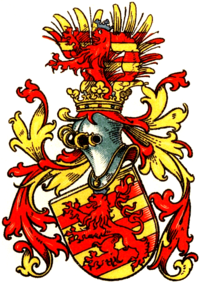Erwitte (noble family)
The Lords of Erwitte were an old Westphalian noble family that died out in the 17th century .
history
The eldest lords of Erwitte belonged to the descendants of Count Haold , like the noblemen of the Lippe , of Itter and of Padberg . The Free County of Erwitte also emerged from his inheritance and initially belonged to the Lords of Erwitte alone. Later it was shared with the Lords of Störmede , and later with the Lords of Hörde . The western part remained in the hands of those of Erwitte.
The parent company was Haus Erwitte . This is said to have been in the family since the time of Bishop Meinwerk von Paderborn in 1022. There is evidence that the house was owned by the family for 1188 and 1309. Later she had to give up this seat. House Erwitte came into the possession of one of the noble Droste families in the 16th century, who have called themselves Droste zu Erwitte since then . Nothing remains of the original building. Other possessions were also sold in the 14th century and later. In the course of time, the formerly wealthy, noble-free family around Erwitte and Geseke seems to have descended into the lower nobility .
A first representative of the family known by name was Eberhard von Erwitte. This first appears in the documents in 1178. At that time he was the governor of the Counts of Arnsberg over Soest . His brother Rudolf was also under bailiff in Soest in 1204. He also had the Langeneicke estate as a fief from the Counts of Arnsberg . A younger Eberhard appears in the documents between 1217 and 1244. The Bailiwick of Soest had meanwhile been lost. Johann von Erwitte and his wife Hildegunde founded the Benninghausen monastery in 1240 . At times they were hereditary bailiffs of the Geseke monastery . They had probably received this from the Counts of Arnsberg, so it was a sub-bailiff. In 1258 Gottschalk I had a serious conflict with the abbess von Geseke. This had given the Bredelar monastery land. Gottschalk claimed this for himself and took possession of it by force. As a result, he was excommunicated. Together with his son Rudolf III. he had to give up numerous bailiwick rights. The free court under royal spell remained with the family.
Dittmar von Erwitte was a royal Danish colonel in 1605 and Dietrich Ottmar von Erwitte was an imperial major general. He was killed in the Battle of Breitenfeld during the Thirty Years' War . His son Ferdinand von Erwitte was abbot of the monastery Werden . After his death, the sex died out.
coat of arms
The coat of arms shows in gold a red gold crowned lion over three red bars. On the crowned helmet with red and gold covers, the lion growing between two gold wings covered with crossbars.
Personalities
- Ferdinand von Erwitte (1628–1706), abbot of Werden and Helmstedt
- Dietrich Ottmar von Erwitte († 1631), Bavarian general sergeant
- Johann von Erwitte , Marshal of Westphalia in 1226
Individual evidence
- ↑ Michael Dreniok: The Bredelar Monastery and the Lords of Padberg. A complicated neighborhood in the Middle Ages. In: Bene vivere in communitate. Contributions to the Italian and German Middle Ages. Münster et al., 1997 p. 183
literature
- Johann Suibert Seibertz: On the topography of the free counties . In: Journal for patriotic history and antiquity. Vol. 25. Münster 1865. P. 181 ff.
- H. Leo: Lectures on the history of the German people and empire . Vol. 4. Halle, 1865. S. 976 ff.
- Ernst Kneschke: New General German Nobility Lexicon . Vol. 3 Leipzig, 1861 p. 152 f.
